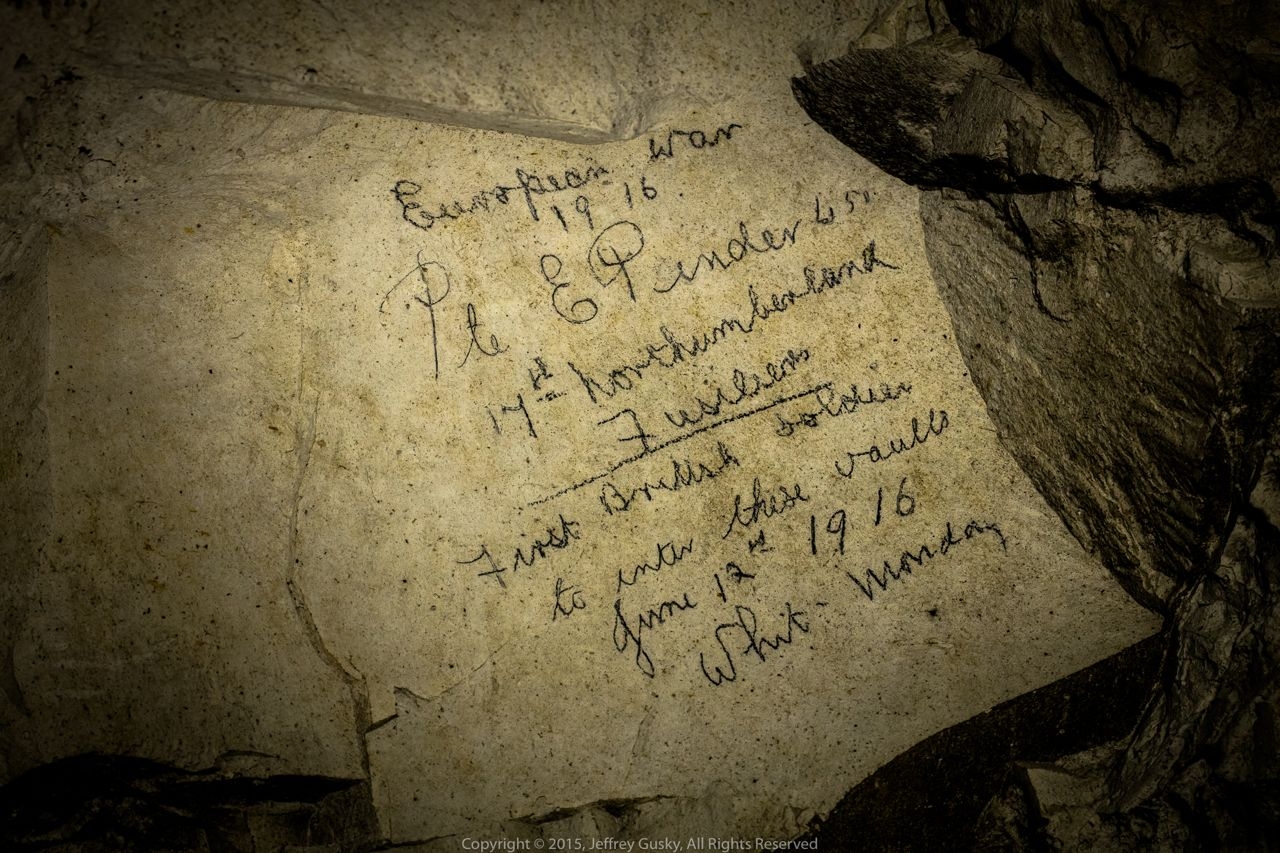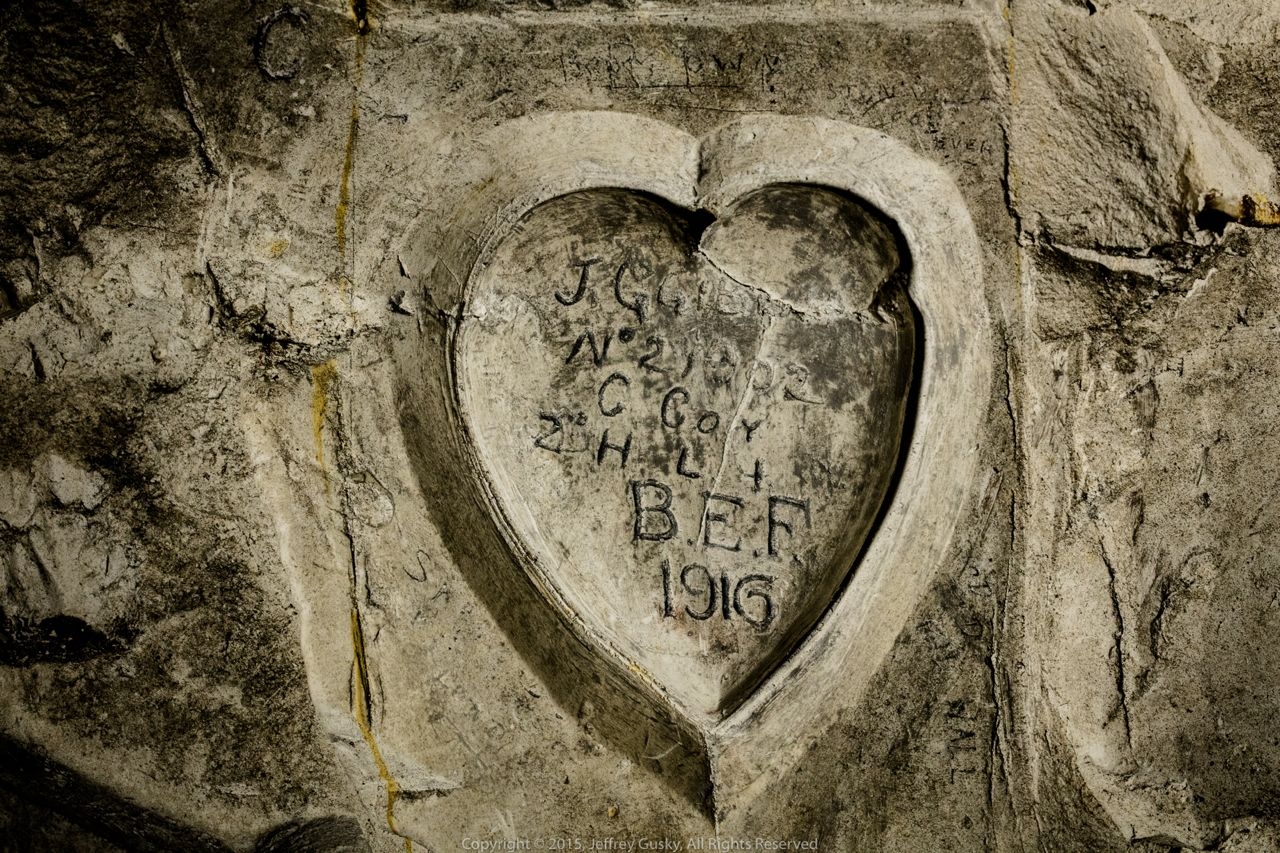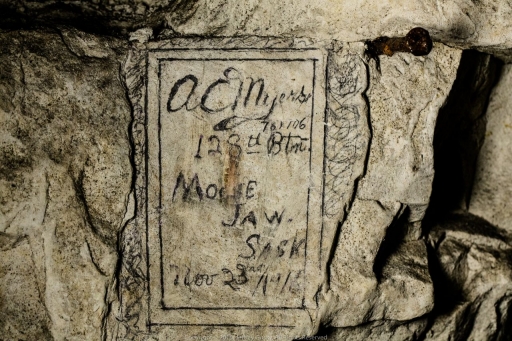Jeff Gusky has shared with Centenary News his latest remarkable photos of underground carvings made by First World War soldiers fighting in France a century ago.
The American photographer has extensively explored caves under the village square of Bouzincourt, cataloguing hundreds of inscriptions left by British and Canadian troops.
In 1916, the village lay close to the battlefields of the Somme and the caves were used to billet soldiers.
Jeff Gusky has visited many other underground sites of the Great War, bringing to light long-lost traces of the conflict through the photographs displayed on his website, The Hidden World of WWI.
Even so, he insists that Bouzincourt, where’s he counted 829 inscriptions, is ‘one of a kind’ and a ‘very emotional shrine of World War I memory for the Commonwealth.’
“So many of these guys would die just after they wrote their names, ” Dr Gusky told Centenary News.
He also believes the caves provided inspiration for The Lord of the Rings author, JRR Tolkien, who served with the British Army at the Battle of the Somme.
 (Photo © 2015 Jeffrey Gusky, All Rights Reserved)
(Photo © 2015 Jeffrey Gusky, All Rights Reserved)
About 500 of the inscriptions are Canadian; the majority of the rest are British, but around 20 Australians left their marks here and there’s also a soldier from the Argentine capital, Buenos Aires.
The carvings are mostly of names, but soldiers’ home towns, serial numbers and regimental badges also feature.
“This place represents the largest repository of Canadian hand-written World War I inscriptions and the second largest British,” Dr Gusky said.
“For the Canadians it is an absolute national treasure, and likewise for the British.”
The caves are reached by descending a concrete spiral staircase for about 40 feet (12 metres) and walking through an arched brick tunnel. Jeff Gusky says they are exactly as they were 100 years ago.
‘Perfectly preserved’
“You fix your eyes closely on any given area in certain parts of the system and you will find name after name, after name, after name. It’s as if they’re looking for any space, almost in desperation, to leave a record that they once existed as a living, breathing human being. It’s very emotional, ” Dr Gusky told Centenary News.
“It’s completely dark, your headlight shines on a wall, and there right in front of your eyes are soldiers’ inscriptions often perfectly preserved like 100 years ago was yesterday.
“It takes on a whole different context when you realise that this was the last time many of these guys would write their names and that is why Bouzincourt is important.
“It is a shrine to people who would soon die on the Somme and they just wanted to be known. There’s a human to human connection that exists nowhere else on the Western Front. I can say that with complete certainty from having been to so many of these places. It’s so close to the fighting and with so many names.”
 (Photo © 2015 Jeffrey Gusky, All Rights Reserved)
(Photo © 2015 Jeffrey Gusky, All Rights Reserved)
Jeff Gusky is convinced that the caves would have been known to JRR Tolkien. He explains that the creator of The Lord of the Rings and The Hobbit repeatedly spent rest periods in the tiny village of Bouzincourt during his four months on the Somme from July-October 1916.
“This place is a netherworld. When you consider Tolkien’s Lord of the Rings and Middle Earth, this is an alternative universe where people are living underground because the surface of the Earth has become inhospitable for human life.
“And so I believe that this is the place where Lord of the Rings was born into Tolkien’s imagination. It’s hard to imagine that he was not down there. Forty feet underground, it was the safest place in the village.
“The fact that he didn’t mention the caves in his journal is not surprising. Soldiers on both sides of the conflict almost never wrote about the places underground where they found sanctuary.”
From his explorations of Great War underground sites across France, Dr Gusky has accumulated around 4,000 names which have lain in darkness for a century.
The aim now, he explains, is to start a ‘global movement’ to revive memories and tell their stories.
“We’re in talks with one of these large genealogy services to help us to create an online forum where people – ranging from family members to students, to hobbyists and professional historians – can pull together and really elaborate on who these young men were bring these stories to light.”
 (Photo © 2015 Jeffrey Gusky, All Rights Reserved)
(Photo © 2015 Jeffrey Gusky, All Rights Reserved)
Jeff Gusky’s collection of pictures from sites of the Great War can be explored on his website, ‘The Hidden World of WWI’. Every day between now and 2019, a new photograph from the collection will be published on his ‘Hidden WWI’ Instagram and Facebook pages.
Dr Gusky’s photography was also featured here in this Centenary News article published in August 2014.
The Bouzincourt caves can be visited on selected days of the year. For information, contact the Mairie de Bouzincourt.
The village is also notable for being the last resting place of Lionel Lupton, great great uncle of Catherine, Duchess of Cambridge. Lieutenant Lupton, killed in July 1916, is buried in CWGC’s Bouzincourt Communal Cemetery Extension.
© Centenary News & Author
Images courtesy of Dr Jeff Gusky (© 2015 Jeffrey Gusky, All Rights Reserved)
